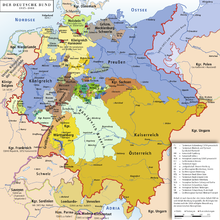德意志割據
外觀


| 德國歷史 |
|---|
 |
| 歷史系列條目 |
德意志割據(德語:Kleinstaaterei;德語:[ˌklaɪnʃtaːtəˈʁaɪ])是一個德語歷史名詞,通常帶有貶義。它用來指神聖羅馬帝國(尤其是在三十年戰爭之後)以及 19 世紀上半葉的德意志邦聯時期,德國和鄰近地區領土邊界的支離破碎[1]。它指的是大量擁有主權的中小型世俗或教會的公國以及城邦,其中一些僅比一個城鎮或帝國修道院修道院的周圍場地大一點。對18世紀的德國邦國總數的估計各不相同,從294個到348個或更多[2]。
由於許多隨意的領土形成或國家通過繼承劃分,大量的神聖羅馬帝國邦國由不連續的部分組成,這導致了無數的飛地。
洪堡的例子可以生動體現出德意志地區邦國割據的程度。1789 年夏天,年輕的威廉·馮·洪堡和他的朋友為了觀察巴黎正在發生的革命事件,計劃從布倫瑞克-沃爾芬比特爾親王國的首府不倫瑞克旅行到法國。洪堡和朋友在到達法國邊境之前進出了六個公國、四個主教轄區和一個自由城市(亞琛)[3]。
參見
[編輯]參考資料
[編輯]- ^ Historian J. Whaley defines Kleinstaaterei as "A (pejorative) term coined in the early 19th century to denote the extreme territorial fragmentation of the Reich". J. Whaley, Germany and the Holy Roman Empire (1493–1806), Oxford University Press, 2011, vol. 2, p. 653 (Glossary).
- ^ The Times, Atlas of European History, Harper Collins, 1994, p. 127
- ^ E. D. Brose, German History 1789–1871, From the Holy Roman Empire to the Bismarckian Reich, Berghahn Books, 1997, p. 4.
